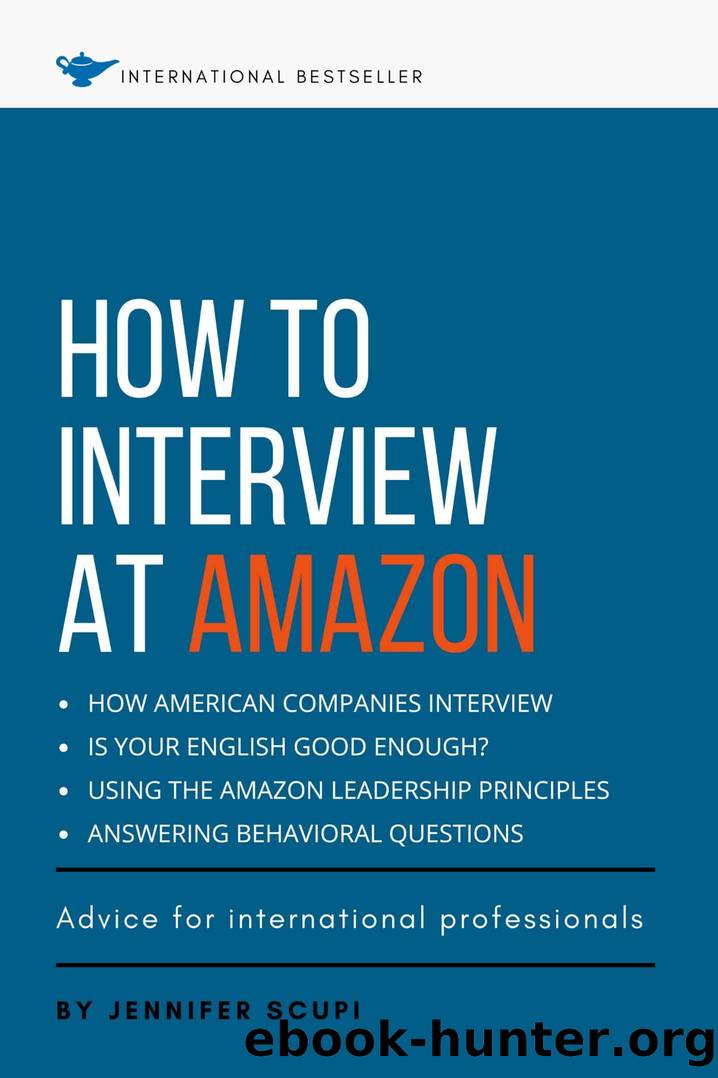How to Interview at Amazon for International Professionals: Learn the American Interview Style and the Amazon Leadership Principles by Jennifer Scupi

Author:Jennifer Scupi [Scupi, Jennifer]
Language: eng
Format: mobi
Published: 2019-10-04T16:00:00+00:00
If you’re planning to work with me, I can definitely help you with your stories but I can’t think of them for you. I get a lot of requests to write answers for clients. How can I write your stories for you if I don’t know what happened to you in your professional life? It’s impossible. I can help you improve your stories, but you’re going to have to write the basic outline yourself.
If I could write your stories for you without knowing you, I would be a billionaire.
How to get enough details for your stories
The first phase of writing a story is thinking of an idea, and the second phase is brainstorming details.
Once you have your idea, write as much info as you can about it. Aim for at least a page of writing. If you can remember any details, write them down. You can also talk to someone who worked on the project with you for more details.
Don’t edit yourself before you write.
If you write everything you can think of down without worrying about whether it’s good or not you’ll think of the most possible details.
Once you’ve remembered everything you can about the incident, then you can extract the best info and turn that into a story.
How to get details relevant to the leadership principles
Amazon interviewers take the leadership principles seriously. One goal of the interview is to see if you’re a good fit with the principles. How do they do this?
In an Amazon interview, the interviewer will ask a behavioral question. It may or may not be in the exact words of the principles. The question might be “How have you shown customer obsession?” (customer obsession is one of the principles) or it might be “Tell me about a time you had to work hard to please a client.” Both of these questions are asking the same question about your focus on client needs.
Make a list of the leadership principles. You may have already started a spreadsheet to keep track of your stories so you can use this.
Start with customer obsession. Do any of the ideas you’ve thought of for stories relate to this principle? You may already have quite a few stories that will fit here. If so, you probably don’t need to focus on this one. Go to the next one. Do you have any ownership stories? If none of your story ideas can work for answers to the ownership questions, you should try to think of more stories here.
Since you won’t know which principles you’ll get asked about, you should have stories that work for them all.
If you’ve made a list of your top accomplishments like I suggested earlier, go through and match each of these to the leadership principle it illustrates.
Some stories may work with more than one principle. In fact, a good story will work with more than one principle, although some stories, like the failure one, fit with one principle only.
You can also plan your stories starting with functional competencies. Do
Download
This site does not store any files on its server. We only index and link to content provided by other sites. Please contact the content providers to delete copyright contents if any and email us, we'll remove relevant links or contents immediately.
| Business School Guides | GMAT |
| Guides | Interviewing |
| Job Hunting | Job Markets & Advice |
| Resumes | Vocational Guidance |
| Volunteer Work |
The Motivation Myth by Jeff Haden(5175)
Audition by Ryu Murakami(4888)
Adulting by Kelly Williams Brown(4534)
The Confidence Code by Katty Kay(4220)
A Mind For Numbers: How to Excel at Math and Science (Even If You Flunked Algebra) by Barbara Oakley(3257)
Waiting in the Wings by Melissa Brayden(3195)
Self-Esteem by Matthew McKay & Patrick Fanning(3115)
Fooled by Randomness: The Hidden Role of Chance in Life and in the Markets by Nassim Nicholas Taleb(3082)
The ONE Thing by Gary Keller(3033)
Nice Girls Don't Get the Corner Office by Lois P. Frankel(3021)
The Dictionary of Body Language by Joe Navarro(2969)
How to be More Interesting by Edward De Bono(2767)
Designing Your Life by Bill Burnett(2699)
Getting Things Done by David Allen(2668)
The Plant Paradox by Dr. Steven R. Gundry M.D(2581)
Police Exams Prep 2018-2019 by Kaplan Test Prep(2516)
What Color Is Your Parachute? 2015 by Richard N. Bolles(2286)
Dangerous Personalities by Joe Navarro(2260)
When to Jump by Mike Lewis(2222)
